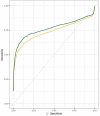Impact of artificial intelligence in breast cancer screening with mammography
- PMID: 35763243
- PMCID: PMC9587927
- DOI: 10.1007/s12282-022-01375-9
Impact of artificial intelligence in breast cancer screening with mammography
Abstract
Objectives: To demonstrate that radiologists, with the help of artificial intelligence (AI), are able to better classify screening mammograms into the correct breast imaging reporting and data system (BI-RADS) category, and as a secondary objective, to explore the impact of AI on cancer detection and mammogram interpretation time.
Methods: A multi-reader, multi-case study with cross-over design, was performed, including 314 mammograms. Twelve radiologists interpreted the examinations in two sessions delayed by a 4 weeks wash-out period with and without AI support. For each breast of each mammogram, they had to mark the most suspicious lesion (if any) and assign it with a forced BI-RADS category and a level of suspicion or "continuous BI-RADS 100". Cohen's kappa correlation coefficient evaluating the inter-observer agreement for BI-RADS category per breast, and the area under the receiver operating characteristic curve (AUC), were used as metrics and analyzed.
Results: On average, the quadratic kappa coefficient increased significantly when using AI for all readers [κ = 0.549, 95% CI (0.528-0.571) without AI and κ = 0.626, 95% CI (0.607-0.6455) with AI]. AUC was significantly improved when using AI (0.74 vs 0.77, p = 0.004). Reading time was not significantly affected for all readers (106 s without AI and vs 102 s with AI; p = 0.754).
Conclusions: When using AI, radiologists were able to better assign mammograms with the correct BI-RADS category without slowing down the interpretation time.
Keywords: Artificial intelligence; BI-RADS classification; Breast cancer; Mammography.
© 2022. The Author(s).
Conflict of interest statement
The authors disclosed no relevant relationships.
Figures



References
MeSH terms
LinkOut - more resources
Full Text Sources
Medical

